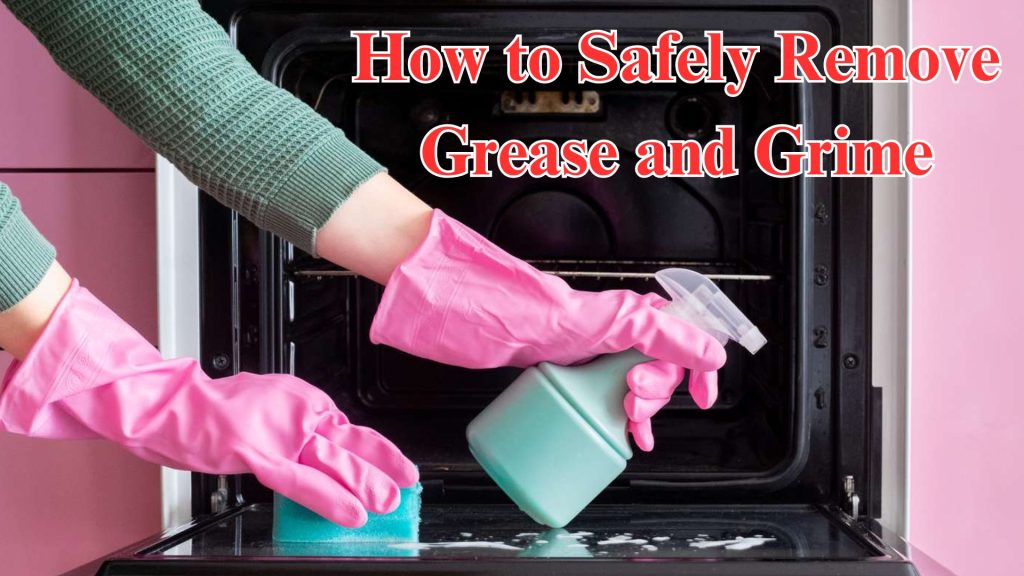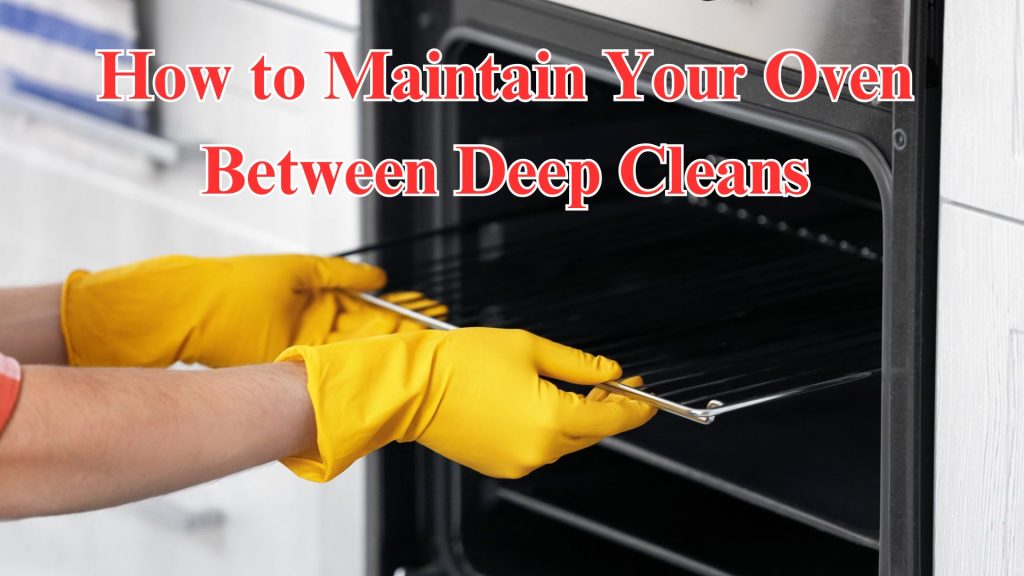Table of Contents
Introduction:
A clean oven is essential for both the taste of your food and the safety of your home. Over time, grease, grime, and food residue can build up, leading to unpleasant odors, smoke, and even potential fire hazards. This guide provides practical tips to help Australian homeowners keep their ovens spotless and efficient, ensuring they’re always ready for the next family meal.
Why Is Cleaning the Oven Often Neglected in Kitchen Maintenance?
Why Oven Cleaning Gets Overlooked
- Out of Sight: Mess hides once the door is closed.
- Build-Up: Grease and grime harden, making cleaning harder.
- Time-Consuming: Deep cleans feel daunting with busy schedules.
- Lack of Tools: Without the right products, it’s frustrating.
- Unpleasant Task: Smells, scrubbing, and awkward positions discourage it.
The Best Natural Cleaning Solutions for Ovens
If you prefer a chemical-free approach, natural cleaning solutions can be just as effective.Baking soda, also known as bi-carb soda, is a powerhouse when it comes to tackling oven grime. Its mildly abrasive texture makes it excellent for scrubbing away tough stains, while its non-toxic nature ensures safety in your kitchen. Additionally, baking soda absorbs odors, making it a versatile cleaning agent.
A simple paste made from baking soda and water can work wonders. Apply the paste to the oven surfaces, let it sit overnight, and then wipe it away with a damp cloth the next day. This method is gentle on your oven and ensures a thorough clean.
For an extra boost, spray the paste with white vinegar. Vinegar, being acidic, can cut through grease and help dislodge baked-on food. When combined with baking soda, it produces a foam through a chemical reaction. While this reaction is fun to watch, it’s more about the individual strengths of each ingredient that makes them effective in cleaning.
It’s worth noting that using baking soda and vinegar separately can often yield better results. The foam is a visual “placebo,” as some experts suggest, so focusing on the unique properties of each can enhance your cleaning efforts.
This combination of baking soda and vinegar offers a safe, non-toxic solution to oven cleaning, ensuring your appliance is spotless without harsh chemicals.
Practical Cleaning Steps
- Sprinkle Baking Soda: Begin by sprinkling baking soda over the surface to be cleaned.
- Scrub: Use a damp sponge or cloth to scrub away the grime.
- Rinse: Wipe up the excess baking soda with a wet cloth.
- Apply Vinegar: Spray or dab vinegar onto the surface, targeting stubborn areas.
- Final Wipe: Once the vinegar has had time to work, give the area a final wipe-down.
Using them separately maximizes their individual strengths, resulting in a cleaner, fresher kitchen space.
How to Clean Your Oven with Dish Soap and Vinegar
Cleaning your oven doesn’t have to involve harsh chemicals. A simple, natural method involves using common household ingredients—dish soap and vinegar.
Start by gathering your supplies. You’ll need a spray bottle, white vinegar, dish soap, and some water.
Steps to Follow:
- Prepare the Cleaning Solution: In a spray bottle, mix equal parts of white vinegar and dish soap. Add a small amount of water to help dilute the mixture, ensuring it’s not too thick for spraying.
- Apply the Mixture: Generously spray the interior surfaces of your oven with the solution. Make sure to cover all areas, focusing on spots with visible grime or stains.
- Let It Sit: Allow the mixture to sit and work its magic for a few hours. This gives the solution time to break down baked-on grease and grime.
- Wipe and Scrub: After waiting, use a cloth to wipe down the surfaces. For tougher spots, employ a brush to scrub away any remaining residue.
By following these steps, you can efficiently clean your oven using simple ingredients from your kitchen. This method is not only effective but also eco-friendly, ensuring your oven looks great without the use of harmful chemicals.
Cleaning Your Oven With a Small Brush
Keeping your oven spotless doesn’t always require high-tech gadgets. A small brush can be an effective tool for this job. Here’s how you can use it:
- Choose the Right Brush: Opt for a small scrubbing brush or even a paintbrush. Their compact size makes them perfect for reaching tight spots.
- Remove Loose Debris: Gently brush away any crumbs or loose grime from the surface of your oven. Pay special attention to corners and edges where dirt tends to accumulate.
- Target Nooks and Crannies: Apply the brush to areas that are difficult to reach with larger cleaning tools. Its size allows for precision, ensuring a thorough clean.
- Add Some Cleaning Solution: Dip your brush in a homemade cleaning solution. A mix of baking soda and water works well. Lightly scrub the interior surfaces with gentle circular motions to lift stubborn stains.
- Finish Off with a Wipe: Once the debris is loosened, use a damp cloth to wipe away what your brush dislodged, leaving your oven spotless.
By using a small brush, you can effectively maintain the cleanliness of your oven without the need for a vacuum or specialized equipment.
Step-by-Step Guide to a Thorough Oven Clean
Easy Oven Cleaning Steps
Racks & Trays:
- Soak in hot, soapy water (or in the bathtub with a dishwasher tablet).
- Scrub with a brush, rinse, and dry thoroughly.
Vinegar Steam (Natural Option):
- Boil equal parts water + vinegar, place pot in oven for 45–60 mins.
- Steam loosens grime for easier cleaning.
Interior:
- Apply natural paste or commercial cleaner (avoid heating elements).
- Let sit 20 mins–overnight, then scrub with a non-abrasive sponge.
- Wipe with a damp cloth, rinse, and dry.
Oven Cleaning Essentials
For Racks:
- Washing powder or dishwasher tablet (for soaking)
- Dish brush or old toothbrush (for corners)
- Non-scratch scouring pad (for stubborn grime)
For Glass Door:
- Hot water + microfiber cloth (streak-free shine)
- Glass cleaner (polished finish)
- Glass scraper (if model allows)
Safely Removing Your Oven Door
- Prep Workspace: Lay a towel on a sturdy surface; wear gloves.
- Unlock Hinges: Fully open the door and release hinge latches.
- Remove Door: Close partway, lift or pull forward to disengage. Get help—the door is heavy.
- Disassemble Glass (if needed): Some models use clips or screws (often Torx T20). Take photos for easy reassembly.
How Often Should You Thoroughly Clean Your Oven?
How Often Should You Clean Your Oven?
- General Use: Deep clean every 3–6 months.
- Frequent Bakers/Hosts: Clean monthly to avoid residue.
- Light Users: Every 6 months with spot cleans in between.
- Self-Cleaning Ovens: Run cycle every 4–6 months, plus manual wipe-downs.
- Clear Signs: Smoke, odors, spills, or heating issues.
How Pyrolytic Self-Cleaning Ovens Work
These ovens heat up to 500°C, burning food residue into ash that’s easily wiped or vacuumed away once cool.
Key Tips to Watch For
- Safety: Door locks during cleaning; ventilate well and keep kids/pets away.
- Power Use: High electricity draw—avoid running other big appliances.
- Parts Check: Remove racks/runners not built for extreme heat.
- Glass Prep: Wipe glass before cycle to avoid baked-on stains.
- Final Step: Once cool, sweep or wipe away ash.
Are Oven Accessories Safe for Self-Cleaning?
Not all! Most racks, trays, and runners can warp or discolor in the extreme heat of a pyrolytic cycle.
- Remove accessories unless marked “pyrolytic safe” by the manufacturer.
- Clean separately with gentler methods to keep them in top shape.
Expert Insights and Additional Methods
To elevate your oven cleaning routine, consider these expert-backed methods:
Harness the Power of Steam
- What You’ll Need:
- Deep baking dish
- Water
- White vinegar (optional)
- Non-scratch scour
- Dishwashing liquid
- Warm and Soften Grime: Preheat your oven to a low temperature (about 110 degrees Celsius). Place a water-filled baking dish inside and let it steam for 1-2 hours.
- Scrub and Clean: Once the oven is warm, remove the dish and racks, scrubbing the interior with a non-scratch sponge and dishwashing liquid. For tough spots, add a natural scrub like bi-carb soda.
The 5-Minute Method
- Clean your oven quickly by wiping it down with dishwashing liquid after each use. This prevents buildup and maintains a clean oven with minimal effort.
These methods offer a balanced approach to oven cleaning, combining natural, gentle solutions with effective, expert-recommended techniques. Whether you choose to steam clean or use a baking soda paste, these strategies ensure your oven remains spotless and ready for your next culinary adventure.
The Steam Method for Efficient Oven Cleaning
Cleaning your oven doesn’t have to be a dreaded chore. The steam method offers an effective way to tackle grease and grime without harsh chemicals. But how exactly does it work? Here’s a step-by-step guide to using steam to restore your oven’s shine.
How the Steam Method Works
The power of steam lies in its ability to soften stubborn baked-on residues, making them easier to wipe away without extensive scrubbing. This method reduces the need for abrasive chemicals, utilizing simple household items instead.
Supplies You’ll Need:
- Deep baking dish
- Water
- White vinegar (optional for extra grease-cutting boost)
- Non-scratch scour pad
- Dishwashing liquid
- Baking soda (optional for tough spots)
Step-by-Step Guide
- Preheat the Oven: Set your oven to a low temperature, around 110 degrees Celsius. This heat level is perfect for creating steam without risk.
- Prepare the Steam Bath: Fill a deep baking dish with water, adding a cup of white vinegar if you’re using it. Place the dish on a rack within the oven.
- Steam and Soften: Allow the oven to stay on for 1-2 hours. During this time, steam will fill the oven cavity, helping to lift and loosen grease and grime.
- Cool and Clean: Once the steaming process is complete, let the oven cool slightly, but keep it warm. Remove the baking dish carefully and take out the oven racks, cleaning them separately in warm, soapy water.
- Scrub Away Residue: Dampen a non-scratch scour pad with a small amount of dishwashing liquid. For areas with persistent grime, sprinkle baking soda on the pad for extra power. Then, scrub all oven surfaces gently.
- Rinse and Dry: Wipe away any leftover detergent with a soft, damp cloth, followed by a thorough drying with a tea towel or paper towels. Finally, replace the oven racks.
This steam cleaning method combines simplicity and effectiveness, leaving your oven clean and ready for your next culinary adventure!
How to Effectively Soak and Clean Oven Knobs
Cleaning oven knobs can often be tricky, but a systematic approach can make all the difference. Here’s a simple method to make them sparkle:
- Detach the Knobs: Start by carefully pulling off the knobs from your oven. Most models allow for easy removal, requiring just a gentle tug.
- Soak in Soapy Water: Fill a large bowl or your sink with warm water, adding a generous amount of dish soap. Submerge the knobs in this soapy solution and let them sit for at least an hour. This process helps loosen and dissolve grease and grime without extra scrubbing.
- Rinse Thoroughly: After soaking, rinse each knob under clean water to eliminate soap residue.
- Allow to Air-Dry: Place the rinsed knobs on a paper or kitchen towel. Ensure they dry completely before putting them back on the appliance.
Using these straightforward steps ensures your oven knobs remain as clean and functional as possible.
Cleaning the Exterior of Your Oven
Stainless Steel:
- Wipe with the grain using hot water + microfiber cloth.
- For shine: buff with white vinegar or citrus cleaner.
- Stubborn spots: use methylated spirits on a paper towel.
Touchscreens & Controls:
- Wipe with a soft, barely damp microfiber cloth.
- For sticky spots: diluted dish soap on cloth (not directly).
- Finish with a dry cloth to remove moisture.
What is the 5-Minute Method for Cleaning an Oven?
The 5-minute oven cleaning method is an efficient routine that ensures your oven remains spotless and ready for use, and it all hinges on regular maintenance. Here’s how it works:
Immediate Action Post-Use
- Routine is Key: Make it a habit to clean your oven right after each use. This prevents grime buildup and makes the process swift and easy.
- Surface Cleaning: Once the oven has cooled down to a warm temperature, lightly dampen a dishcloth and add a speck of dishwashing soap.
- Wipe Down: Thoroughly wipe all interior oven surfaces with the soapy cloth, tackling any splatters or spills.
- Rinse and Dry: Rinse the cloth thoroughly to eliminate soap residue, and then wipe the interior again to clear away any lingering suds. Finish by drying the surfaces with a paper towel or tea towel.
Caring for the Oven Racks
- Separate Wash: Remove the racks and clean them using dishwashing liquid. Rinse them well, dry them completely, and then place them back in the oven.
By adopting this quick routine, your oven will not only stay pristine but also significantly extend its lifespan and efficiency. This method offers a fuss-free approach to a cleaner kitchen space.

Dealing with Stubborn Baked-On Food – Oven Cleaning Tips
Baked-on food can be tough to remove, but with the right tools, it’s manageable. For particularly stubborn spots, apply a thicker layer of baking soda paste or use a commercial oven cleaner. Let it sit for an extended period (overnight if possible) to soften the residue. Use a plastic scraper to gently lift the debris without scratching the oven’s surface. Follow up with a thorough wipe-down using a damp cloth.
You may also like to read about-“Can I eat food that was in the oven while it was self-cleaning”
How to Use a Power Drill as a Creative Oven Cleaning Hack
Step 1: Gather Your Materials
Before you begin, you’ll need a power drill and a set of cleaning attachments. These sets typically include brushes and sponges that can be used throughout your home, making them a versatile investment.

Step 2: Attach the Cleaning Tool
Choose a brush or sponge from your cleaning attachment set. Secure it onto the drill, ensuring it’s tightly fastened to prevent any wobbling or damage while in use.
Step 3: Apply Cleaning Solution
Select a cleaning solution suitable for ovens. Whether it’s a homemade mix or a commercial cleaner, apply it generously to the surfaces inside your oven.
Step 4: Power Up and Clean
With your drill set to a low speed, begin scrubbing the inside of your oven. The rotating motion will significantly reduce effort compared to manual scrubbing. Focus on particularly stubborn spots but be careful not to apply too much pressure, which might scratch the oven’s surface.
Conclusion
Keeping your oven clean doesn’t have to be overwhelming. With the right tools, a mix of natural or commercial solutions, and smart routines like the 5-minute method or steam cleaning, you can prevent heavy build-up and keep your appliance running at its best. Whether it’s tackling stubborn baked-on food, polishing glass doors, or even using clever hacks like a power drill attachment, regular care saves time, boosts efficiency, and ensures every meal tastes fresh.
Want a spotless oven without the hassle? Book a professional oven cleaning with Dirt2Tidy today. Our expert cleaners use safe and effective methods to restore your oven, glass, and racks to a sparkling finish—leaving you with more time to enjoy cooking.




